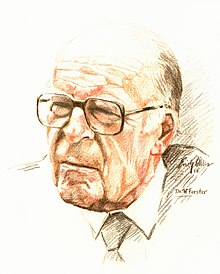Walter Forster (entomologist)
Walter Forster (born July 12, 1910 in Hörbach near Augsburg ; † December 25, 1986 ) was a German zoologist and butterfly scientist .
Life
Walter Forster attended schools in Augsburg and Memmingen , which he graduated from high school in 1930. He first studied political science , but after a year he switched to studying zoology , which he began in Königsberg and completed in Munich with a doctorate on a subject of the bluebells (Lycaenidae) under Hans Krieg in 1936. He then became an assistant at the Zoological State Collection in Munich , initially as a non-scheduled employee, in 1943 as a scientific assistant and from 1949 as a conservator. A particular merit was that he outsourced the collections during World War II in order to save the holdings. The collections came to Freising, Polling Abbey, Neu Egling near Murnau and Ohlstadt. The Old Academy in Neuhauserstrasse, which housed the State Zoological Collection, was practically completely destroyed by bombs on the night of April 25, 1944. After the Second World War, the Zoological State Collection was temporarily housed in the north wing of the Nymphenburg Palace. From 1957 Forster headed the entomological department as a department director and was finally director of the Zoological State Collection from 1965 to 1975.
Dr. Forster was very closely associated with the Munich Entomological Society. For many years he was the editor of the Entomological Society's announcements, founded the "Nachrichtenblatt der Bavarian Entomologen" in 1951 and the Bavarian Entomologists' Day in 1962, which has been held annually in Munich ever since. In 1943 he became secretary of the Munich Entomological Society and from 1961 to 1985 he was 1st Chairman of the Munich Entomological Society.
Many scientific trips took him to Southeast Europe, South America, East Africa and Iran, among others . He also supported the research company in Nepal and in the Himalayas , which had its seat in the Zoological State Collection under Walter Hellmich . Walter Forster acquired a detailed knowledge of literature, species knowledge and history in the entomological field. During his tenure, the insect collections of the Zoological State Collection were expanded to become the most important of the great natural history museums. The focus was on butterflies ( Lepidoptera ), beetles ( Coleoptera ), hymenoptera ( Hymenoptera ) and two-winged birds ( Diptera ). Another significant part of his work was expanding the library.
Fonts
Between 1954 and 1981 Walter Forster wrote the texts for the five-volume work “The Butterflies of Central Europe”, which Theodor A. Wohlfahrt illustrated with drawings and watercolors of the butterflies. The texts about the individual species are partly kept short, but contain a description of the first stands for almost every species, including the main forage plants of the caterpillars. In taxonomic terms, the work reflects the status of the 1950s to 1970s. It is one of the standard works for the determination of day and night butterflies:
- with Theodor A. Wohlfahrt: The butterflies of Central Europe. Volume 1: Biology of Butterflies. Franckh'sche Verlagshandlung, Stuttgart 1954, DNB 456642161 .
- with Theodor A. Wohlfahrt: The butterflies of Central Europe. Volume 2: Butterflies. (Rhopalocera and Hesperiidae). Franckh'sche Verlagshandlung, Stuttgart 1955, DNB 456642188 .
- with Theodor A. Wohlfahrt: The butterflies of Central Europe. Volume 3: Weirdos and Swarmers. (Bombyces and Sphinges). Franckh'sche Verlagshandlung, Stuttgart 1960, DNB 456642196 .
- with Theodor A. Wohlfahrt: The butterflies of Central Europe. Volume 4: Owls. (Noctuidae). Franckh'sche Verlagshandlung, Stuttgart 1971, ISBN 3-440-03752-5 .
- with Theodor A. Wohlfahrt: The butterflies of Central Europe. Volume 5: Spanner. (Geometridae). Franckh'sche Verlagshandlung, Stuttgart 1981, ISBN 3-440-04951-5 .
Walter Forster also translated and edited the German edition of "The butterflies of Europe and North West Africa". (Original title: "A field guide to the butterflies of Britain and Europe" by Lionel O. Higgins and Norman D. Riley ). He shifted the focus of the presentation from British to general European conditions and adapted them to new taxonomic knowledge. In 1959 he translated the work Living Insects of the World (German title: Knaurs Tierreich in Farben: Insects) by Alexander Barrett Klots and Elsie Broughton Klots.
Individual evidence
- ↑ G. Scherer: Dr. Walter Forster (1910–1986) Director of the State Zoological Collection 1965–1975 . In: Spixiana Supplement 17, 1992, pp. 201–202.
- ^ Ernst-Gerhard Burmeister, Erich H. Diller: 100 Years of Munich Entomological Society. V. A historical outline. In: Bavarian Entomologists' newsletter. Volume 053, 2004, p. 7, PDF on ZOBODAT
- ↑ Wolfgang Dierl: Walter Forster to the memory. In: Bavarian Entomologists' newsletter. Volume 037, 1988, pp. 1-3, PDF (423 kB) on ZOBODAT
- ^ Lionel G. Higgins, Norman D. Riley: The butterflies of Europe and Northwest Africa . Verlag Paul Parey, Hamburg et al. 1971, ISBN 3-490-02418-4 , p. 6 .
Web links
- Literature by and about Walter Forster in the catalog of the German National Library
| personal data | |
|---|---|
| SURNAME | Forster, Walter |
| BRIEF DESCRIPTION | German zoologist and butterfly scientist |
| DATE OF BIRTH | July 12, 1910 |
| PLACE OF BIRTH | Hörbach |
| DATE OF DEATH | December 25, 1986 |
